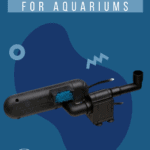If you’ve ever had an outbreak of Green Water algae in your aquarium, you know how hard it can be to eliminate those pesky single-celled organisms. One of the most effective ways to keep free-floating algae under control is to use an ultraviolet sterilizer. Let’s take a look at what the best UV sterilizers can do for your tank!
Quick Comparisons of the 6 Best UV Sterilizer For Aquariums
| IMAGE | BRAND | DETAILS | |
|---|---|---|---|
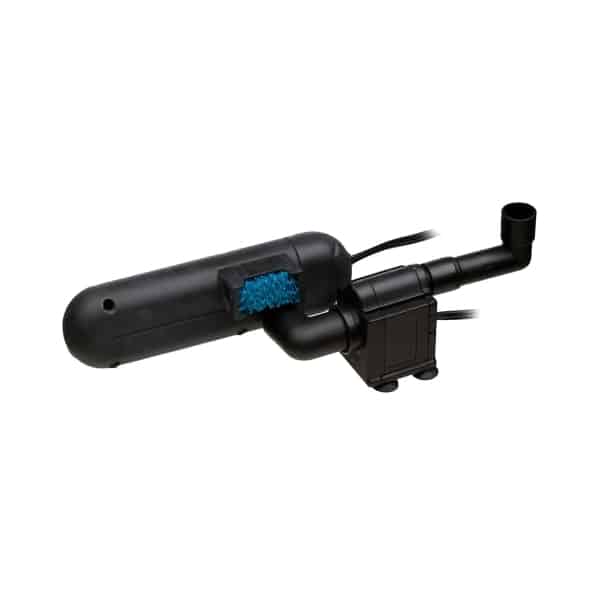 | Green Killing Machine Internal UV Sterilizer with Power Head |
| View Product |
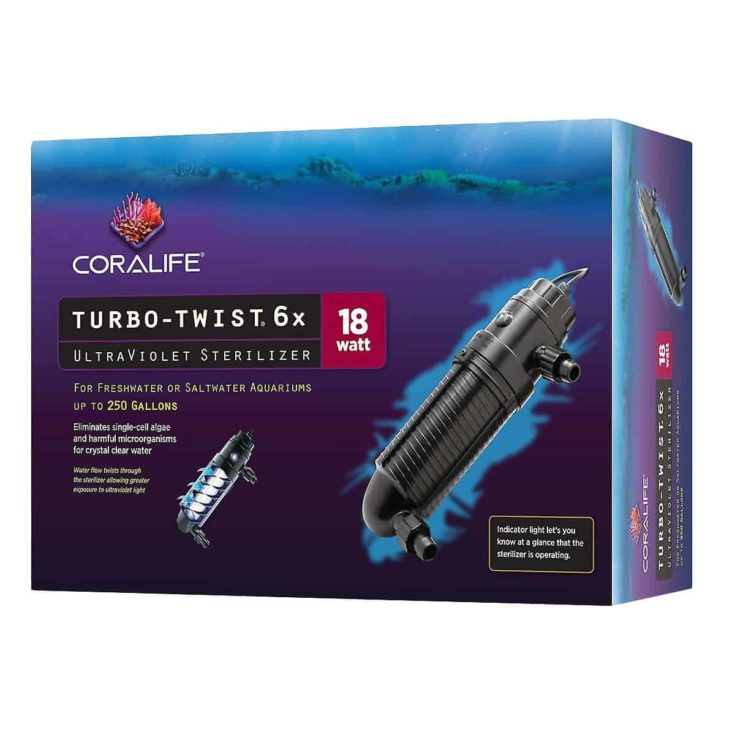 | Coralife Turbo-Twist Ultraviolet Sterilizer |
| View Product |
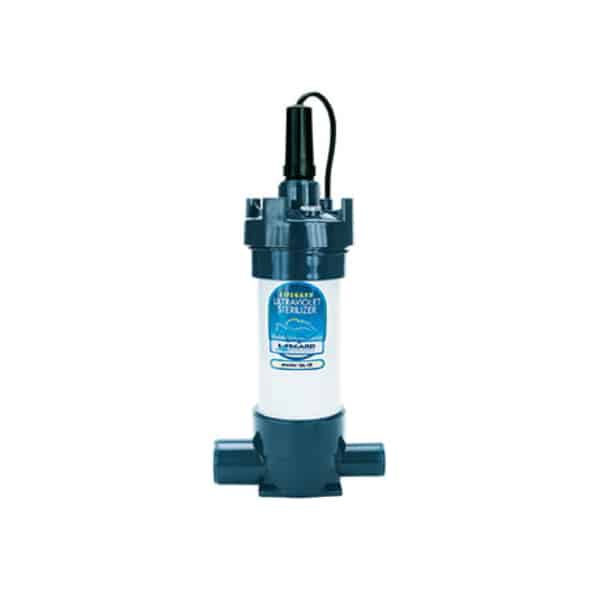 | Lifegard Aquatics QL UV Water Sterilizer, 15 Watts |
| View Product |
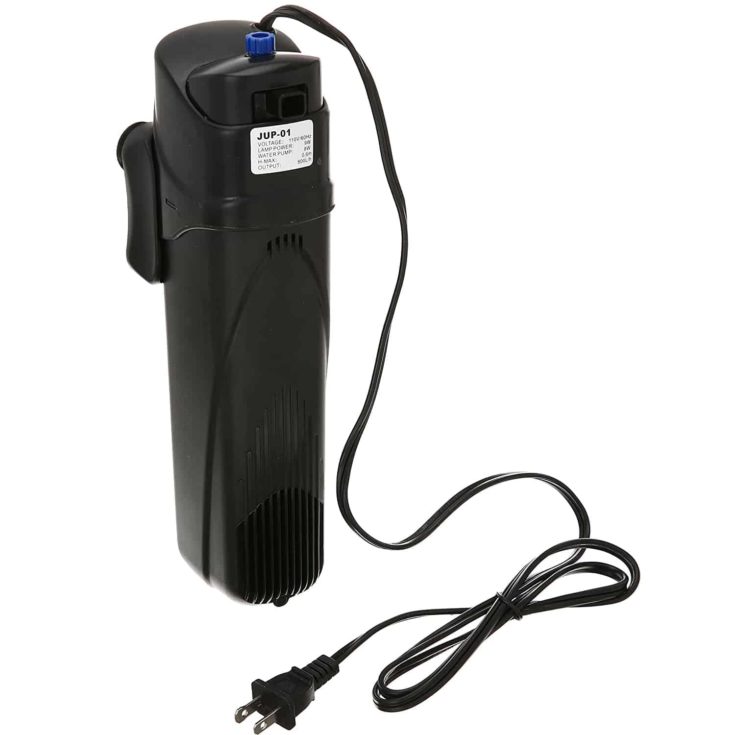 | SunSun 9W UV Sterilizer |
| View Product |
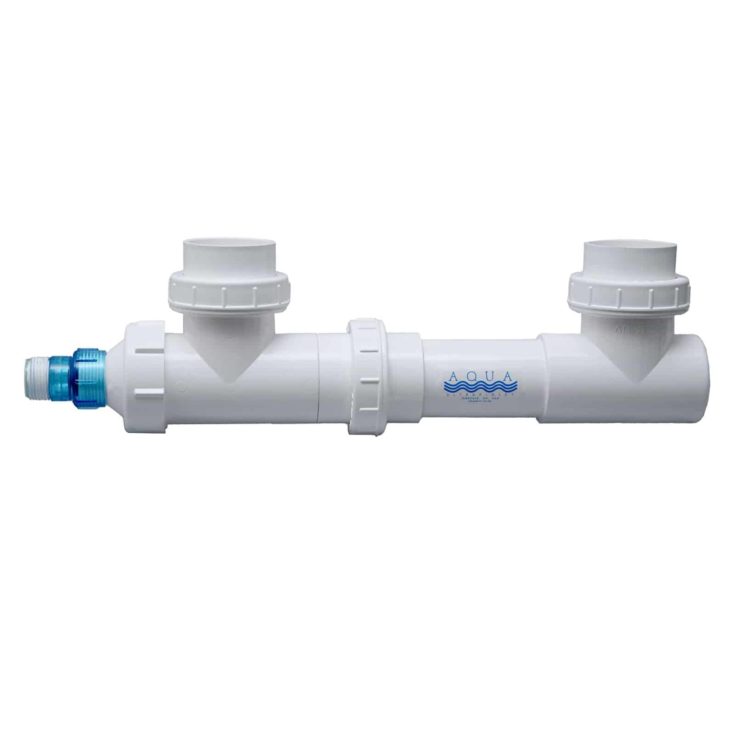 | Aqua Ultraviolet 25-watt UV Sterilizer for Aquarium |
| View Product |
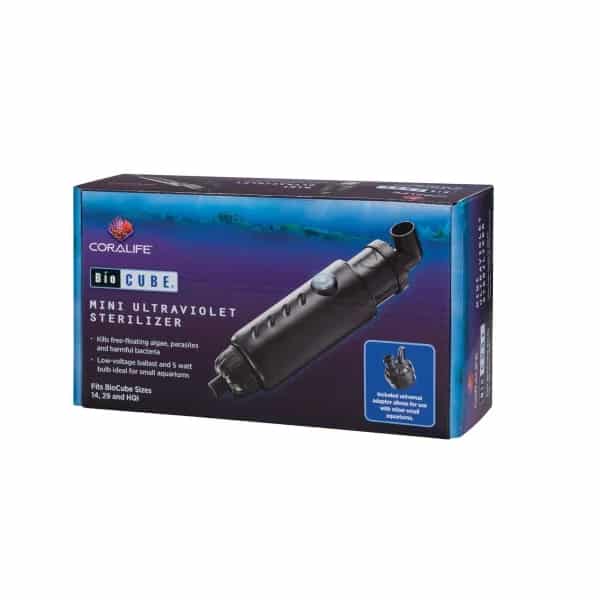 | Coralife BioCube Mini UltraViolet Sterilizer |
| View Product |
Top 6 Aquarium UV Sterilizer Reviews
These are some of the most popular models available and some are even professional quality or suitable for pond systems as well as aquariums. Any of these models can eliminate nasty algae blooms and many can also be set-up for true sterilization!
1. AA Aquarium Green Killing Machine Internal UV Sterilizer

- Style: Internal/Submersible
- Max Flow Rate: 37 GPH
- Aquarium Capacity: 20 to 50 Gallons
- Wattage: 9 watts
If you’re looking for an inexpensive UV sterilizer for a small freshwater or marine tank, this plug-and-play model from Green Killing Machine could be a good choice. At 9 watts, it’s not very powerful, but the built-in powerhead gives you the freedom to put it anywhere in your tank.
It’s a great option for keeping algae at bay and boosting the health of your fish, and the sealed bulb design makes the replacement trouble-free. It even has a removable pre-filter to increase the UV penetration, and the dwell time is reasonable for a compact sterilizer.
The Green Machine is probably a bit underpowered for a 50-gallon, but it could be a good choice for tanks 20 to 40 gallons. I wouldn’t use it on a saltwater tank over 20-gallons, though. The set-up makes this one of the easiest to use, too.
| PROS | CONS |
|---|---|
|
|
2. Coralife Turbo-Twist Ultraviolet Sterilizer

- Style: In-line
- Max Flow Rate: 200 to 400 GPH
- Aquarium Capacity: Up to 250 Gallons
- Wattage: 18 watts
If you’d like a robust clarifying sterilizer that has the potential for more, the flexible Turbo-Twist model from Coralife might be a good option. You can buy a separate powerhead or pump and mount it directly to your tank with a bracket, or hook it into your existing filtration system and control the flow rate with the filter’s pump.
This sterilizer does a great job at water clarification and should improve the health of your tank’s occupants. But if you’re getting it primarily for pathogen control and not algae you’ll need to pay close attention to the set-up. It’s not easy to calculate or achieve the ideal flow rate for Level 1 sterilization.
In that case, you might be better off getting help from a professional who can evaluate your set-up and the best installation method. If you need true sterilization, the Turbo might not be the ideal choice, but for algae control, it’s a strong option.
| PROS | CONS |
|---|---|
|
|
3. Lifegard Aquatics QL UV Water Sterilizer

- Style: Modular In-line
- Max Flow Rate: Up to 240 GPH
- Aquarium Capacity: Unspecified
- Wattage: 15 watts
The modular UV sterilizer from Lifegard Aquatics is an interesting option. If you have an extensive aquatic set-up or a pond, this professional quality system could be a good investment. Designed to work seamlessly with other LA modular filters, this solid unit can also be hooked into a canister filtration system.
It’s not the easiest system to couple to a regular canister filter and you may need to look for parts at a hardware store to pull it off. You’ll also have to seal the lines with silicone, so it’s not one you can easily adjust once it’s set-up.
The LA is ideal for an experienced aquarist with multiple tanks running from a common sump or filtration system and isn’t really designed for a casual hobbyist or single small aquarium. But for true sterilization, this is one of the better picks!
| PROS | CONS |
|---|---|
|
|
4. SunSun 9W UV Sterilizer

- Style: Internal/Submersible
- Max Flow Rate: 210 GPH
- Aquarium Capacity: Up to 75 Gallons
- Wattage: 9 watts
If you like the look of the Green Machine but prefer a sterilizer with more pumping power, then this submersible option from SunSun could be the pick for your tank. It comes with a powerful built-in pump, so you won’t have to invest in an extra powerhead, and can sit horizontally or vertically to better hide behind the decor.
This is one of the least expensive options on my list and is ideal for smaller freshwater tanks up to 75 gallons and saltwater up to 30. It does a good job at water clarification, and the removable pre-filter sponge helps decrease water turbidity and increases the performance.
I have a few reservations about this model, though. The seals on the unit are not robust and the glass tube that protects the UV bulb often cracks during shipping. I doubt the SunSun would stand up to years of use. It’s not as easy to set-up as the Green Machine, either.
| PROS | CONS |
|---|---|
|
|
5. Aqua Ultraviolet 25-watt UV Sterilizer for Aquarium

- Style: In-line
- Max Flow Rate: Clarification 2000 GPH/Sterilization 1200 GPH
- Aquarium Capacity: Freshwater 500 to 4000 Gallons/ Saltwater 150 to 400 Gallons
- Wattage: 25 watts
If you want the best UV sterilizer for freshwater aquariums, this premium model from Aqua Ultraviolet is the ideal pick. Designed for large aquariums and pond systems, the Aqua can be set-up for both clarification and true sterilization! It’s rated for both freshwater and marine tanks, and ponds up to 4000 gallons.
The Aqua comes with detailed installation instructions, and the durable and weatherproof case is safely used outside. You’ll need a separate pump that can push 1200 to 2000 GPH through the sterilizer as well. The manufacturer provides excellent customer support and replacement bulbs and parts are easy to source.
This unit would be my choice for a true UV sterilizer, and it does come in smaller models suitable for nano and mid-sized tanks. But the premium price makes it less desirable for hobby fish keepers and it’s probably overkill for a small set-up.
| PROS | CONS |
|---|---|
|
|
6. Coralife BioCube Mini UltraViolet Sterilizer

- Style: Submersible In-line
- Max Flow Rate: 300 GPH
- Aquarium Capacity: Up to 32 Gallons
- Wattage: 5 watt
Algae is a common problem in small nano tanks, so Coralife designed the Mini submersible in-line sterilizer for their line of BioCube tanks. The 5-watt bulb provides basic water clarification but is underpowered if you’re looking for true sterilization. It’s the smallest sterilizer on my list and one of the few suitable for nano tanks.
This sterilizer is an ideal pick if you own a BioCube or similar all-in-one nano tank. While the unit must stay submerged while in use, unlike many in-line sterilizers, the compact size allows it to fit into most filter compartments. You’ll have to hook it into your filter pump, or provide an external pump or powerhead to use it.
My primary reservation with the Mini is that it seems to have been discontinued, so parts and bulbs may be tricky and expensive to source. With limited options for nano tanks, this is still a reasonable option for the right family.
| PROS | PROS |
|---|---|
|
|
Introduction to Ultraviolet Aquarium Filters
While UV sterilizers have long been a popular high-end addition for experienced aquarists with large tanks or ponds, recently many compact and budget versions of these products have joined the market. What do these filters do, and should you invest in a UV sterilizer for your tank?
What Are UV Sterilizers and How Do They Work?

UV sterilizers are a type of filter that cleans your aquarium by passing the water close to an ultraviolet light source. Exposure to UV radiation can cause damage to, and even kill, single-celled organisms such as algae, bacteria and viruses. Using a UV sterilizer can reduce algae and disease outbreaks in your tank.
There are several different types and styles of aquatic UV sanitizers, but they all work in a similar fashion:
- The UV bulb plugs into a narrow protective housing and is sealed inside the case.
- A pump forces your aquarium water around and down the UV bulb inside the sterilizer, exposing the stream to ultraviolet radiation.
- Depending on several factors, including the wattage of the bulb and the length of time the water is exposed to the UV light, single-celled organisms and potentially even parasites are damaged or killed by the radiation.
- Damaged cells are unable to reproduce, lowering the chances of an algae or disease outbreak in the tank.
Are Aquarium UV Sterilizers Harmful to Fish or People?
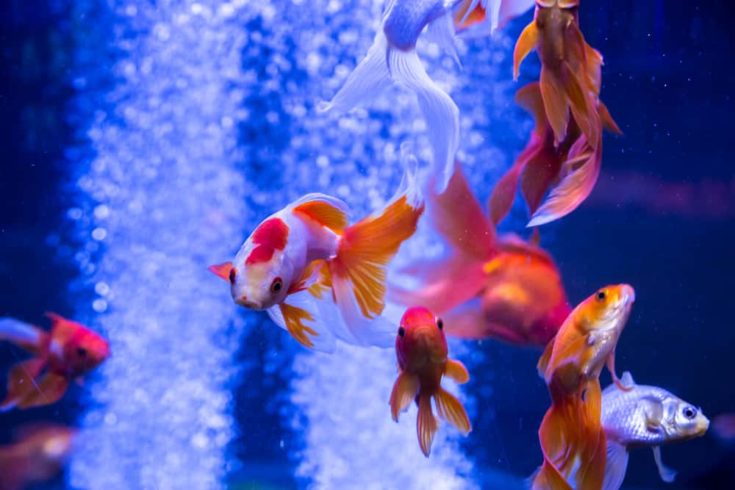
The word “radiation” often causes concern about the safety of UV sterilizers. These units use a bulb that produces short waves of UVC radiation. If the light bulb can kill algae, bacteria, viruses and even some parasites, isn’t it dangerous to your fish or the people in your home?
You’ll want to avoid looking directly at the UV light to prevent damage to your eyesight, and you shouldn’t handle the bare bulb when the light is on. But the fixture should be safe for your fish and household. The UVC rays can’t travel through the protective casing, and won’t hurt your fish or the people around your tank.
Do UV Sterilizers Kill the Good Aquarium Bacteria?
UV sterilizers have the potential to kill any cells that pass through, including good bacteria in your water column. However, the majority of useful bacteria in your tank live in your substrate or biofilters and don’t float in the water. You should avoid using a sterilizer on a new tank while it’s cycling, however.
Benefits of UV Sterilizers
UV sterilizers provide several benefits for aquariums and ponds. Their most useful function is that of a water clarifier. Reducing the numbers of free-floating algae in your tank can dramatically increase your water clarity. Most sterilizers also help prevent outbreaks of cyanobacteria, known as the stubborn blue-green algae.
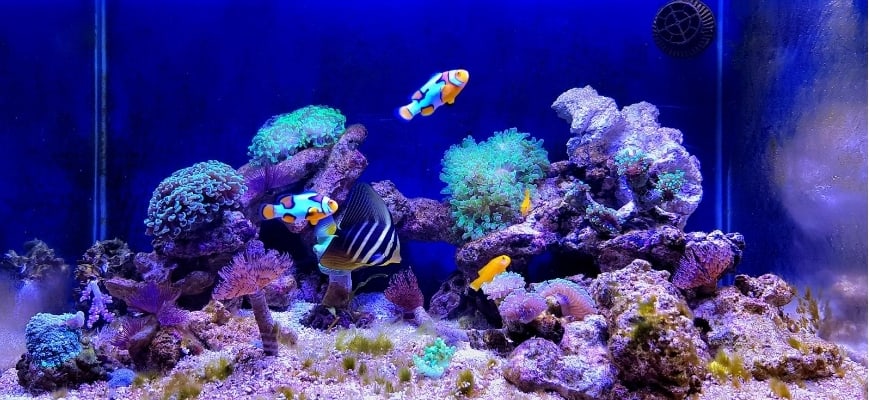
UV sterilizers can also kill other types of bacteria and viruses, and the top-of-the-line models with powerful UV bulbs can even target parasites floating in the water. Your actual results will vary depending on the type and style you choose and how it’s installed and maintained.
There’s one further benefit to using a UV sanitizer, even a simple budget model. Studies indicate that using a UV sanitizer in an aquarium reduces the stress on fish and strengthens their immune systems. So even if your sterilizer is unable to totally kill pathogens, your fish will be healthier and less likely to get sick!
The Truth About UV Sterilizers in Aquariums
There’s a lot of reasons why UV sterilizers (even the most expensive) don’t actually sterilize aquarium water or your tank. You’ll still have to do regular maintenance on your filters and perform water changes to maintain good water quality. UV sterilizers are not a replacement for proper maintenance!
Algae, bacteria, viruses and parasites aren’t just free-floating in your water column. They’re often hidden in your substrate, on your decorations, or even attached to your fish or corals. Even a top-notch sterilizer can only target pathogens floating in the water and not those in other parts of your tank or filtration systems.
| Benefits of UV Sterilizers | Downsides |
|---|---|
|
|
How to Maximize the Performance of UV Sterilizers
UV sterilizers are simple devices in theory, but this is definitely one topic that gets very complicated the more you research. Like searching for the best aquatic light fixtures, the devil is very much in the details. What factors affect the set-up and performance of your UV sterilizer?
Water Turbidity and Filtration
Aquarium water is filled with microscopic minerals, dissolved organic compounds (DOCs) and other debris that increase the turbidity of the water and reduce the effectiveness of your UV sterilizer. These particles can block the radiation from your target cells if they are not filtered out first.
To get the best performance, place the sterilizer at the end of your filtration system where the water returns to the tank. For internal/submersible models, be sure they have a well-maintained pre-filter to reduce the turbidity, although they likely won’t be as effective as an in-line sterilizer.
Water Temperature
UV sterilizers perform best at warmer temperatures. When the water is cooler, you’ll need a longer dwell time in the sanitizer to compensate for the decrease in power. UV bulbs usually work best at 68 to 104°F, although the dry bulb types with quartz sheaths can handle the lower temperatures on a cold water tank.
Size and Wattage
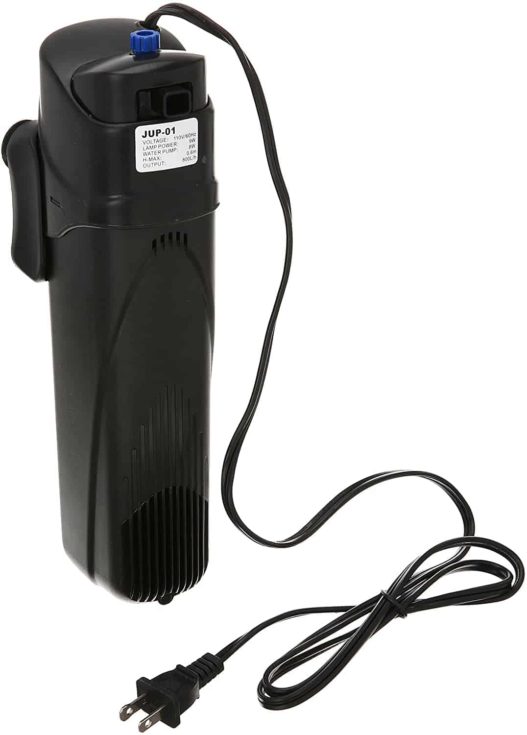
Most in-line and internal aquarium sterilizers are only a few inches wide at most, while canister and pond systems are wider. There’s a trade-off at play. The light is less powerful as you move away from the bulb, but wider chambers allow a higher volume of water to move through every hour.
UV bulbs are rated by the amount of power they use per hour in watts. Small UV sterilizers often use 9 or 15-watt bulbs and limit the gap around the bulb to around 3 cm for better performance. Wider canister and pond sterilizers can handle larger flow rates, but may also allow pathogen-filled water to bypass the radiation zone.
Bulb Quality and Age
UV bulbs vary widely in quality, and that can have a dramatic effect on the power of your UV sanitizer. Wattage only indicates the amount of energy a bulb uses and not the energy produced. As your UV bulb ages, it also loses power by as much as 60%, so it’s best to replace them every 6 months.
The highest-performing and most expensive UV lights are the low-pressure mercury and high-output (HO) bulbs, while the cheaper medium-pressure mercury lights are often found in budget sanitizers. They work more effectively at lower temperatures but also produce less UV radiation per watt.
Dwell Time and Flow Rate
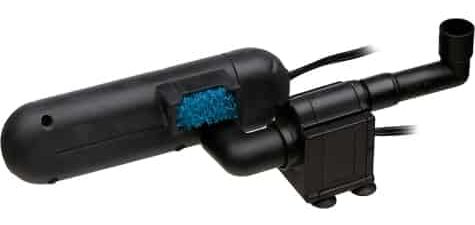
The dwell time is the length of time the water is within the range of the UV bulb. Since the water flows around and down the length of the bulb, longer bulbs result in a longer exposure or dwell time. It’s not quite that simple, because you can alter the dwell time by changing the rate at which the water flows through the sterilizer too.
Calculating the ideal dwell time and flow rate can be tricky. While other sites toss out quick formulas you can use, I find this less helpful for novice fish keepers than just following the manufacturers recommended tank ranges. If you need true sterilization, I recommend seeking expert advice on your set-up.
Choosing Your UV Sterilizer
Now that you know the details on how to maximize their performance, let’s talk about their features and how you can identify the best sterilizer for your tank.
What Sterilization Level Do You Need?
The most important factor when looking at sterilizers is what kind of microorganisms they can kill. Are you looking to banish algae blooms, or protect fish from specific diseases or parasites? Sterilizers can function at three different levels:
Clarifying Sterilizer
- All aquarium sterilizers can damage and kill free-floating algae in your water column, and many also remove weaker bacteria and viruses.
- Clarifying sterilizers can quickly clear algae outbreaks and prevent them from recurring.
- Budget and compact models usually perform in this range, even if they are advertised as UV sterilizers.
Level 1 Sterilization
- After water clarification comes the first level of true sterilization, which targets floating bacteria and viruses.
- Level 1 systems also clear algae faster and better than clarifying sterilizers.
- The majority of full-sized aquarium UV sterilizers fall in this range.
- BUT the sterilizer’s dwell time and flow rate, along with the strength of the bulb and the water turbidity, impact whether it can achieve true sterilization or just clarification.
Level 2 Sterilization
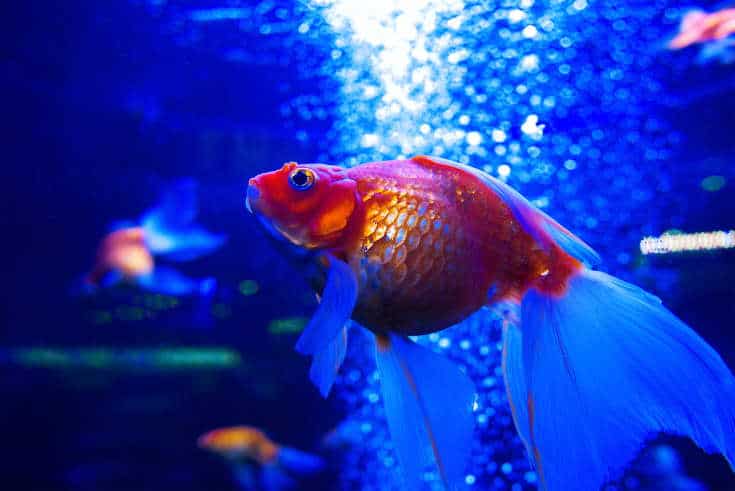
- At the highest level, powerful UV sterilizers can also kill many microscopic parasites, resistant viruses and even types of attached algae.
- They have more powerful and longer UV bulbs to maintain the ideal dwell time without reducing flow rates.
- Usually premium systems and used in large-scale industrial operations like fish hatcheries and public aquariums.
- This level of sterilization is rarely practical or even helpful for a small home aquarium.
For water clarification, most UV sterilizers will be effective even if they are not set up in an ideal fashion. But if you need true sterilization, I highly recommend getting advice on your model and precise set-up from an expert.
Types and Styles of UV Sterilizers for Aquariums
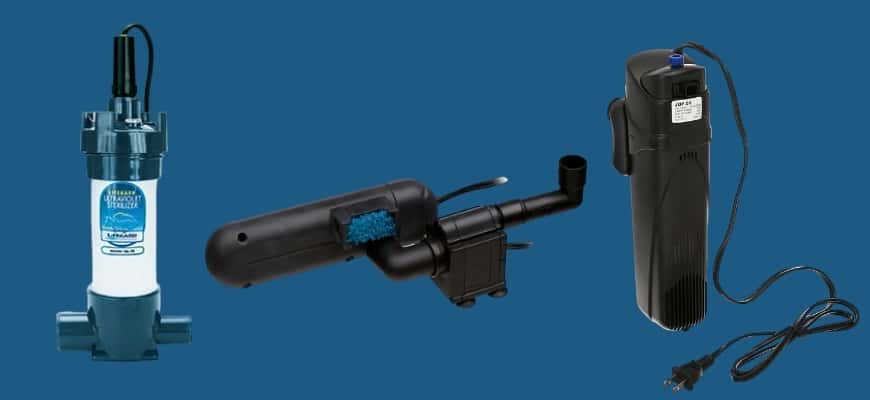
There’s three types of sterilizers: tray, wet tube and dry tube bulbs. Most modern UV sterilizers are either the wet tube type, where the water is exposed directly to the bulb, or the dry tube type, where the bulb is encased in a quartz sheath. For coldwater tanks and ponds, the quartz-covered dry bulbs usually perform best.
UV Wand Sanitizers
Simple UV tubes wrapped in a clear sheath that sits permanently inside your aquarium and look similar to a LED strip light. They may passively help clarify water but that’s about the best you can expect.
HOB and Canister UV Sterilizers
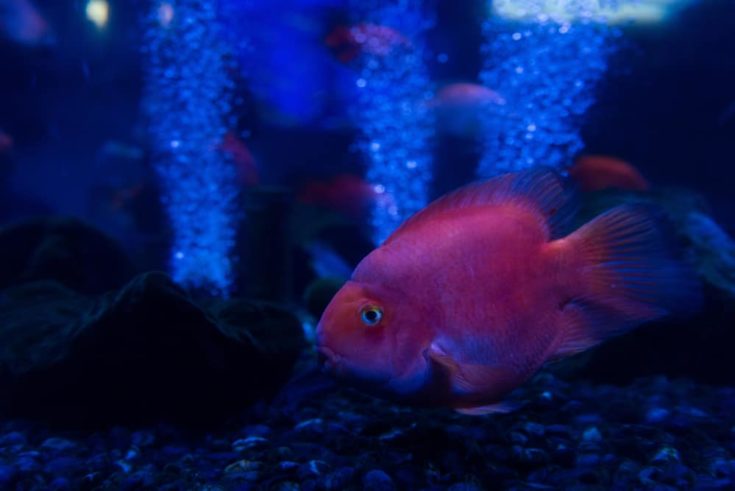
HOB and Canister UV Sterilizers are incorporated into an aquarium filter, usually after the filter pads and media stages. They can clarify your water but usually don’t do well at sterilization, although I’ve had success with a canister system that reduced disease outbreaks.
Internal and Submersible UV Sterilizers
Sits inside your tank and usually come with a powerhead or built-in pump to control your flow rates. They do a good job at water clarification, but water turbidity decreases their sterilizing ability. Better versions have a pre-filter to remove debris in the water before it reaches the light.
In-line UV Sterilizers
Hooks directly into your existing filtration system, usually right before the water returns to the tank. They are the most flexible and effective style, and the only one that can potentially be set-up for level 1 or 2 sterilization. You can also adjust the placement of the intake/outflow to maximize your tank’s circulation.
What Type of Tank Do You Have?
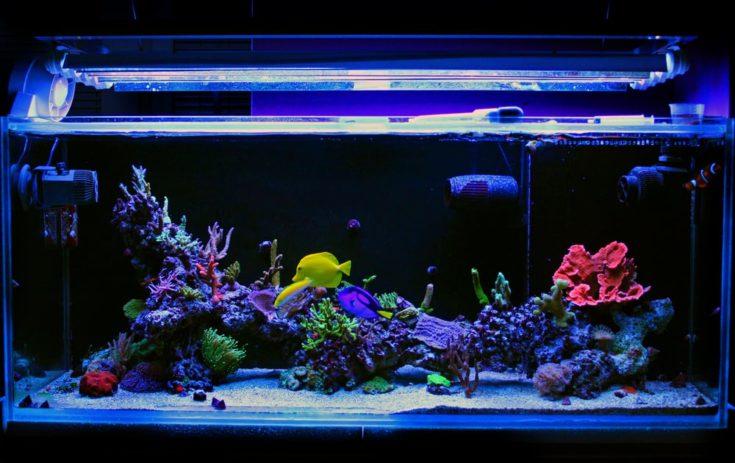
Saltwater naturally has higher water turbidity than freshwater, so UV rays can’t penetrate as deeply. If you’re looking for a sterilizer for a marine or reef tank, be sure to check the specs for saltwater set-ups or you might end up with a device that isn’t powerful enough to have much effect on your water.
Tips for Maintaining Your Aquarium UV Sterilizer
If you want the best performance for years to come:
- Clean the UV bulb and quartz sheath at least once a month to remove any gunk or debris on the fixture that can reduce the light output. I usually do this during my monthly filter maintenance.
- Replace the UV bulb after 6 months of use, or the equivalent amount of use-time if you’re not running it 24/7.
- Invest in high-quality replacement bulbs, and avoid the cheap options available online.
Conclusion
Investing in a UV sterilizer for your aquarium or pond is a great way to reduce algae blooms and prevent disease outbreaks, and also improves the health of your fish. These devices are most useful for water clarification, but many models can also achieve true sterilization if set-up and maintained properly.
I’d love to hear about your experiences with UV sterilizers, so drop a note in the comments or join us on social media! To recap my advice:
- For a professional quality UV sterilizer that can clarify water and provide true sterilization I recommend the Aqua Ultraviolet or the Lifeguard Aquatics, depending on the size and design of your current set-up.
- For excellent water clarification in small and mid-sized tanks, the Green Killing Machine is an inexpensive pick and is the easiest to set-up and use.
The Coralife Turbo-Twist has a flexible design and provides great clarification for larger tanks, but is less ideal if you need true sterilization.
